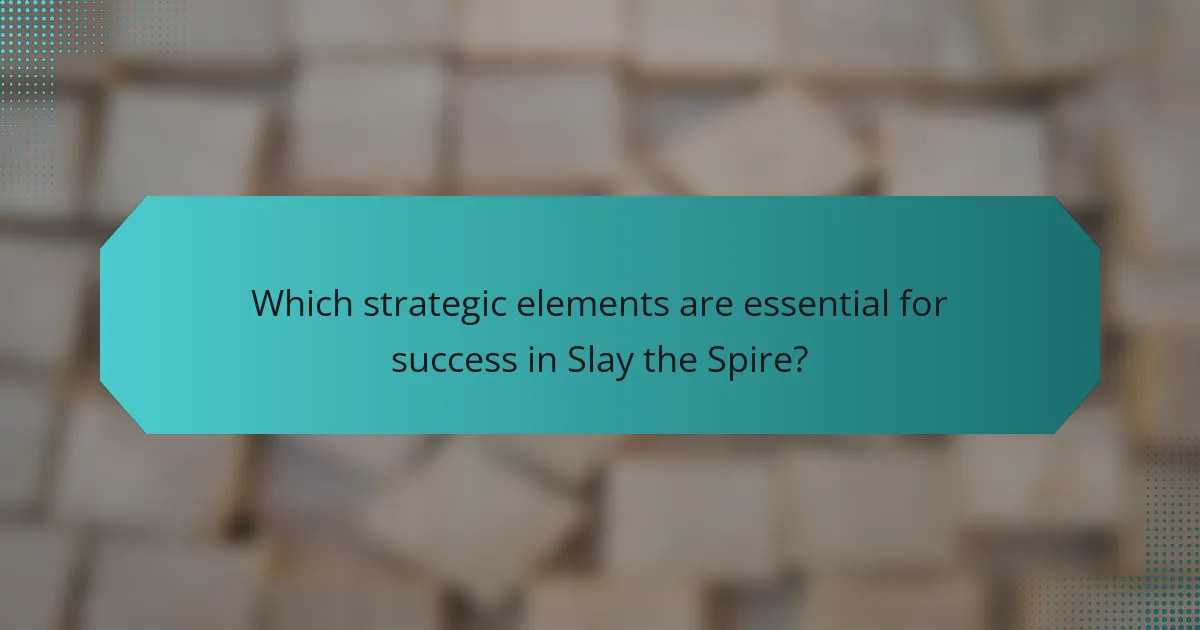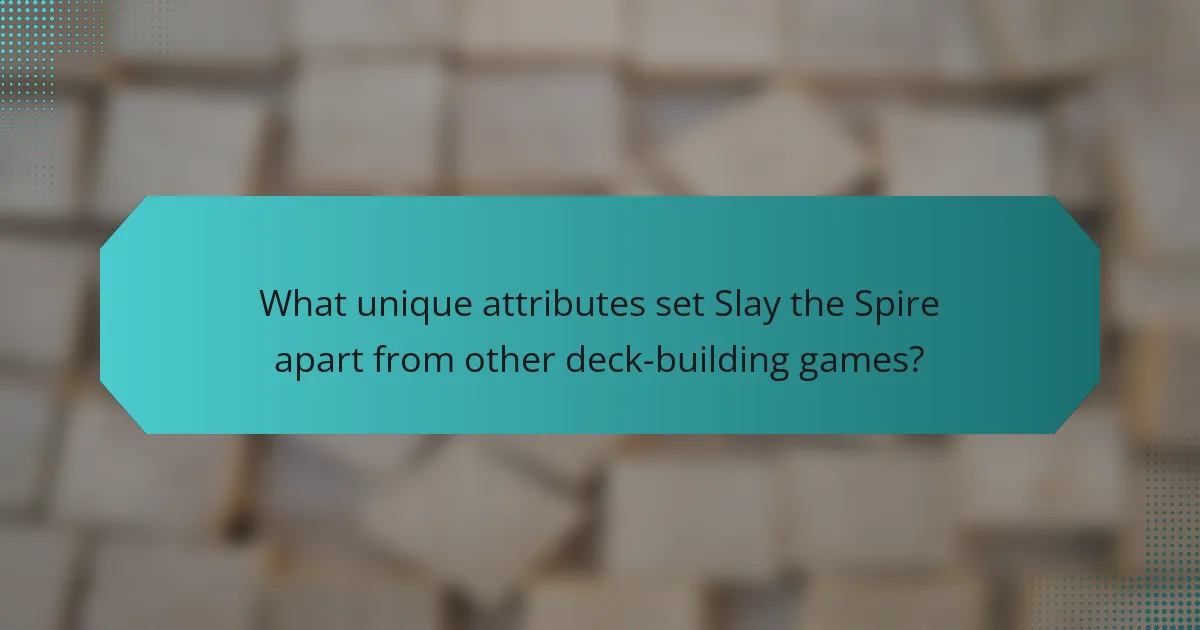Slay the Spire offers engaging deck-building mechanics that enhance strategy and replayability. Key elements include card drafting, deck thinning, and synergy building. Effective strategies involve deck optimization, resource management, and adaptability. The game’s diverse character classes and randomization elements ensure unique experiences with each playthrough.

What are the core deck-building mechanics in Slay the Spire?
Slay the Spire features core deck-building mechanics that enhance strategy and replayability. Key mechanics include card drafting, deck thinning, and synergy building.
Card drafting allows players to select cards from a diverse pool, influencing their strategy. Deck thinning helps improve draw consistency by removing weaker cards. Synergy building focuses on creating powerful combinations of cards that enhance gameplay effectiveness.
These mechanics contribute to the game’s dynamic nature, encouraging varied strategies in each playthrough. Players can experiment with different cards and builds, enhancing the overall replayability of Slay the Spire.
How do card synergies influence gameplay?
Card synergies significantly enhance gameplay by creating powerful combinations that leverage the strengths of individual cards. In “Slay the Spire,” players can build decks where cards complement each other, leading to more effective strategies. For example, combining cards that deal damage with those that provide energy can create explosive turns. Synergies can also dictate the choice of cards during gameplay, encouraging players to adapt their strategies based on available options. This dynamic fosters replayability, as each run can yield different combinations and outcomes.
What role do relics play in deck-building strategy?
Relics significantly influence deck-building strategy in Slay the Spire by providing unique effects and bonuses. They enhance gameplay by offering powerful abilities that can change how a player approaches encounters. For instance, some relics improve energy management, while others boost card effectiveness or provide defensive capabilities. This variety allows players to tailor their decks to specific strategies, maximizing their chances of success. Furthermore, the combination of relics with card choices creates a dynamic interplay that increases replayability and strategic depth.
How does energy management affect card usage?
Energy management significantly influences card usage in Slay the Spire by determining how efficiently players can deploy their cards. Effective energy management allows players to maximize their turns by playing more cards, which enhances strategic options and increases the chances of victory. For example, understanding energy costs and generating additional energy through relics or abilities can lead to more powerful combinations. Players who master energy management can create decks that synergize well, leading to greater replayability and varied strategies.

Which strategic elements are essential for success in Slay the Spire?
Effective strategy elements for success in Slay the Spire include deck optimization, resource management, and adaptability. Players must build a balanced deck that synergizes card effects. Resource management involves careful use of health, energy, and relics. Adaptability allows players to adjust strategies based on the evolving challenges presented by enemies and events. Understanding these elements enhances gameplay and increases chances of reaching the top of the spire.
How can players effectively manage health and resources?
Players can effectively manage health and resources in Slay the Spire by prioritizing card selection and strategic planning. Focus on acquiring healing cards and items, as they directly impact health recovery. Monitor resource management, particularly energy and gold, to optimize card plays and purchases. Choosing relics that enhance resource efficiency can provide significant advantages. Additionally, understanding enemy patterns aids in making informed decisions, allowing players to conserve health and resources throughout their run.
What strategies can be employed for boss encounters?
To succeed in boss encounters in Slay the Spire, employ strategies like deck optimization, status effect management, and resource conservation. Focus on building a balanced deck that synergizes cards effectively. Utilize status effects to weaken bosses while maintaining your health and energy. Prioritize conserving resources for critical moments in the fight. Adapt your strategy based on the boss’s unique attributes and attack patterns to maximize your chances of victory.
How does understanding enemy patterns enhance strategy?
Understanding enemy patterns enhances strategy by allowing players to anticipate attacks and optimize card usage. Recognizing these patterns enables more effective deck-building and decision-making during encounters. Players can exploit weaknesses and adjust their strategies accordingly, resulting in higher chances of success. Mastery of enemy behaviors also contributes to the game’s replayability, as players can experiment with different approaches to overcome challenges.

What factors contribute to the replayability of Slay the Spire?
The replayability of Slay the Spire stems from its diverse deck-building mechanics, strategic depth, and randomization elements. Players encounter varied card combinations, character classes, and relics, creating unique gameplay experiences each run. The game’s roguelike structure ensures different challenges and outcomes, enhancing its replay value. Additionally, player decisions impact strategies, fostering a sense of discovery and mastery over time.
How do different characters affect playthrough experiences?
Different characters in “Slay the Spire” significantly impact playthrough experiences by offering unique abilities and strategies. Each character has distinctive mechanics that shape deck-building options and overall gameplay. For instance, the Ironclad features a strength-based approach, allowing players to focus on powerful attacks, while the Silent emphasizes agility and poison tactics, promoting a different strategy. As a result, players will experience varied challenges and opportunities based on their character choice, enhancing replayability and engagement. The diversity in character attributes encourages experimentation and adaptation, making each playthrough unique.
What impact do random events have on game outcomes?
Random events significantly influence game outcomes in Slay the Spire by introducing unpredictability. These events can alter player strategies, forcing adaptation to new circumstances. For instance, random encounters may provide unique rewards or challenges that change deck-building decisions. The integration of these elements enhances replayability, as each playthrough offers different experiences based on the randomness encountered. This dynamic keeps players engaged and encourages experimentation with various strategies.
How does player choice influence replayability?
Player choice significantly enhances replayability in “Slay the Spire” by introducing diverse strategies and outcomes. Each decision impacts deck composition, character abilities, and route selection, leading to unique gameplay experiences. Players can experiment with different card combinations and relic synergies, encouraging exploration of various strategies. This variability fosters a dynamic environment where no two runs feel the same, keeping players engaged over multiple sessions.

What unique attributes set Slay the Spire apart from other deck-building games?
Slay the Spire stands out due to its innovative mechanics, strategic depth, and high replayability. Unique attributes include its hybrid deck-building and roguelike elements, allowing players to craft personalized strategies with each run. The diverse character classes provide distinct play styles, enhancing the game’s variability. Additionally, the dynamic event system introduces a range of choices, affecting player progression and outcomes uniquely in every session.
How does the roguelike element enhance player engagement?
The roguelike element significantly enhances player engagement by introducing unpredictability and variety. Players experience unique challenges with each run, leading to diverse strategies and deck-building opportunities. This constant evolution keeps gameplay fresh and encourages repeated attempts to conquer the game’s obstacles. Additionally, the element of risk versus reward in decision-making fosters a deeper connection to the game, as players weigh potential gains against possible setbacks. The unique combination of randomized encounters and permanent upgrades amplifies the replayability factor, making each session uniquely compelling.
What innovative mechanics are exclusive to Slay the Spire?
Slay the Spire features innovative mechanics such as relics, card synergies, and ascension levels that enhance strategy and replayability. Relics provide unique bonuses that alter gameplay, while card synergies create powerful combinations. Ascension levels introduce increasing difficulty, challenging players to adapt their strategies. These mechanics foster a dynamic gaming experience, making each run distinct and engaging.

Which rare attributes can players discover during gameplay?
Players can discover rare attributes such as unique relics and powerful cards during gameplay in Slay the Spire. These elements enhance strategy and replayability. Rare relics provide distinct advantages, like altering card effects or granting additional resources. Unique cards often introduce new mechanics or synergies, allowing for diverse deck-building experiences. Discovering these attributes adds depth and excitement to each playthrough, encouraging exploration and experimentation.
What uncommon card combinations yield surprising results?
Uncommon card combinations in Slay the Spire can yield surprising results by exploiting synergies and unexpected mechanics. For instance, pairing cards like “Clumsy” with “Noxious Fumes” can create a unique strategy that leverages poison effects despite Clumsy being typically detrimental. Another example is combining “Echo Form” with “Heavy Blade” to amplify damage output in a single turn. These combinations often lead to creative strategies that defy conventional deck-building logic. Exploring these unusual pairings enhances the game’s replayability and strategic depth.
How do hidden achievements impact the overall experience?
Hidden achievements enhance the overall experience in “Slay the Spire” by adding layers of discovery and motivation. Players often feel a sense of accomplishment when unlocking these achievements, which encourages exploration of different strategies and deck-building mechanics. This aspect promotes replayability, as players are driven to experiment with various characters and card combinations to uncover all hidden achievements. The thrill of achieving something unexpected contributes to a richer gaming experience, making each playthrough unique.
What are some lesser-known strategies that can be effective?
Utilizing lesser-known strategies can significantly enhance your gameplay in Slay the Spire. One effective approach is to focus on synergy between card types. For example, combining cards that generate energy with those that require energy can create powerful turns.
Another strategy is to prioritize relics that complement your deck’s theme. Relics like the “Bottled Flame” can give early-game boosts to key cards. Additionally, consider using the “Scry” mechanic to cycle through your deck more efficiently, allowing you to draw essential cards when needed.
Employing a flexible strategy to adapt to the cards you acquire during a run can be beneficial. This means not rigidly sticking to a predetermined deck plan but instead adjusting based on the cards and relics offered.
Lastly, experiment with different ascension levels to discover unique challenges that can refine your skills and strategies. Each ascension level alters game mechanics, encouraging innovative tactics and enhancing replayability.
What are the best practices for maximizing deck efficiency?
To maximize deck efficiency in Slay the Spire, focus on synergy, card balance, and optimal energy use. Prioritize cards that complement each other, ensuring a cohesive strategy. Maintain a balanced mix of attack, defense, and utility cards to adapt to various encounters. Efficient energy management allows for more powerful plays, enhancing overall performance.